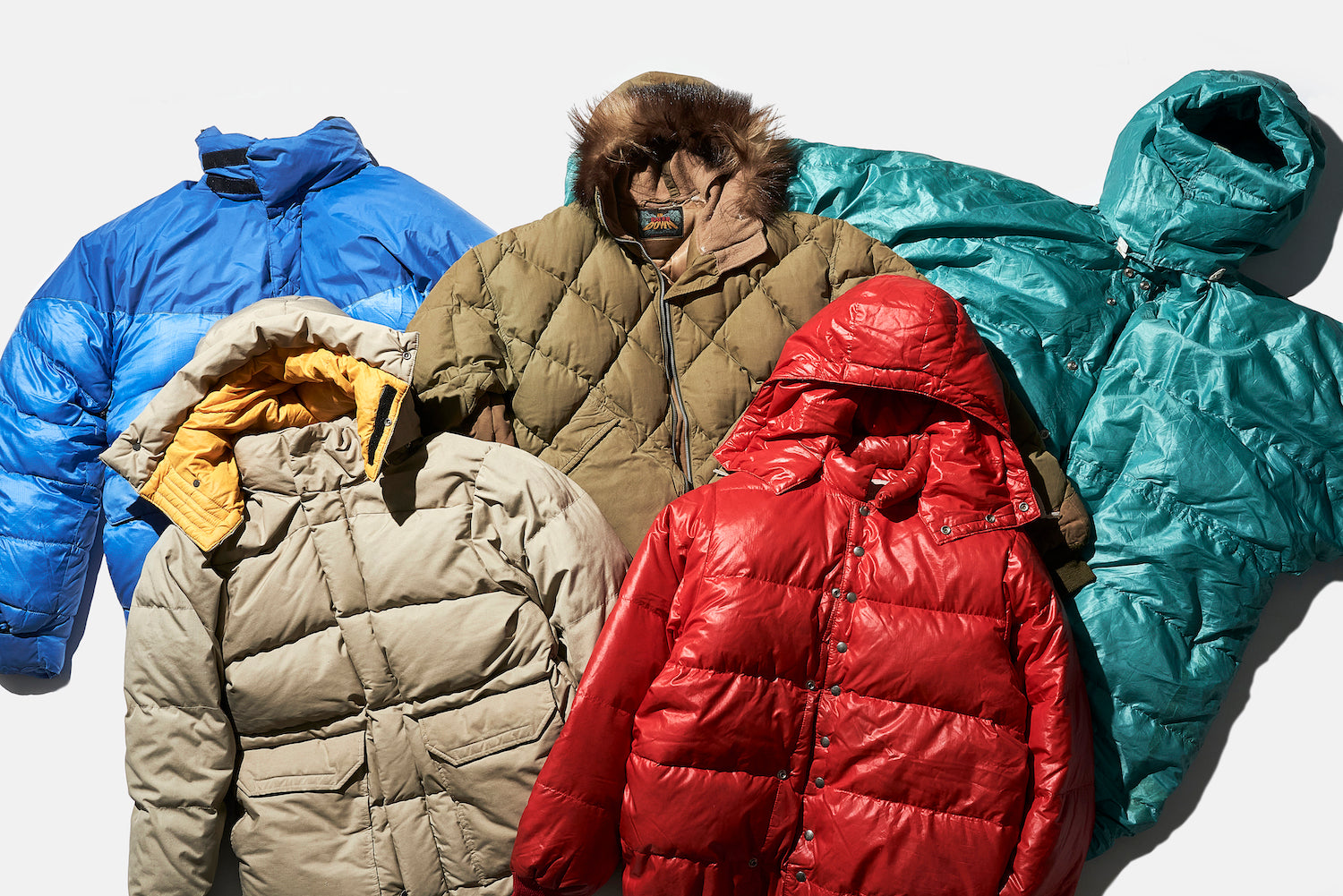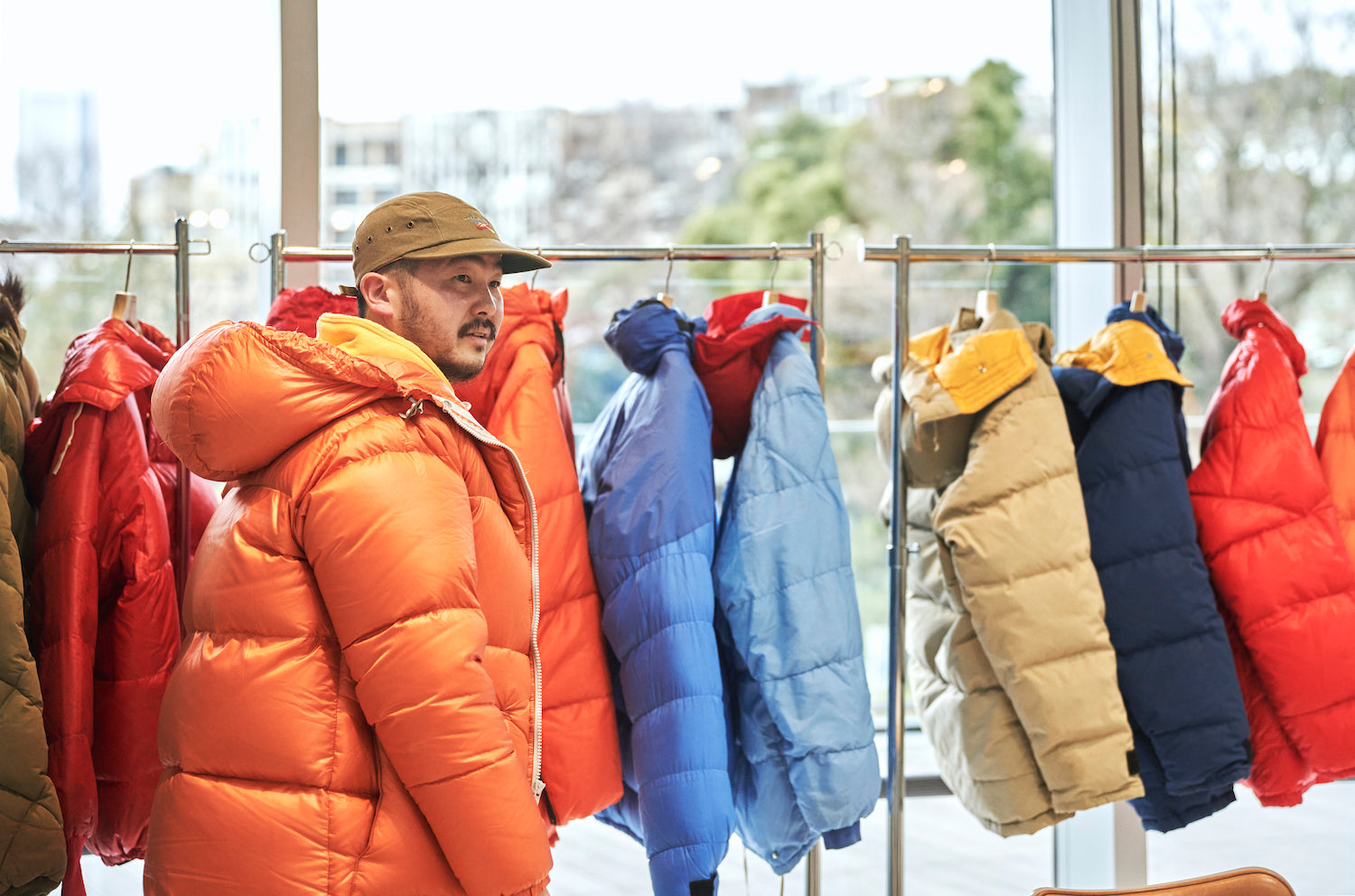Vintage Clothing Prep School Lecture 5: Functional beauty honed through feedback from the polar regions, the classic Expedition Down Parkas known as "wearable sleeping bags."
Lecturer: Shigeru Kaneko




Beams Plus Chief Buyer
Born in 1984, he graduated from the stylist department of Bunka Fashion College and worked part-time at Beams Harajuku before joining the company in 2008. He was appointed buyer at Beams Plus in 2015. He has a deep knowledge of second-hand clothing and is skilled at creating and buying items that reconstruct vintage items. His collection of outdoor items in particular is well-known in the industry. He is also well-known for his unique styling skills that combine vintage items.
Instagram: @shigerukaneko
Let's start with the basics. In 1936, Eddie Bauer released the world's first down jacket, the "Skyliner." After the war, the Expedition Down Parka was rapidly developed and evolved by various brands from the 1950s onwards. What era was the one that "met your standards"?
The items I collect are mainly classical styles commonly known as "old" among vintage outdoor enthusiasts, but I don't really care about the era. Like workwear and military garments, I don't buy the so-called popular items that later became standard, but rather items with unique detail work, specifications, materials, and color combinations that can be used as hints or references for making elaborate clothes, and I ended up with a certain amount of variety (laughs). I use that knowledge in my current work.
So your collection is not for daily use or as a fashion statement, but is strictly for expeditions?
That's right. During and after the war, mountaineers and adventurers from all over the world aimed to reach unexplored polar regions, such as summiting the Himalayas and conducting Antarctic surveys. However, while European expedition down parkas were specifically designed for mountaineering, American parkas, as can be seen from catalogs of the time, focused on a broader definition of expedition, including Alaskan exploration and field sports such as hunting and fishing. I think that this difference in interpretation, or rather the broadness of the range, is what made it so American at the time.

Are European expeditions primarily aimed at mountain climbing?
I don't have a deep understanding of Europe, because I've only used the so-called prestigious brands such as Blacks from the UK and Moncler from France. The purpose was mountaineering, and at least the mass-produced products were not intended for polar exploration. However, if you trace the origins of American products, you will arrive at the European alpine series down parkas. Looking at the catalogs from that time (the 1950s), it seems that REI also released products made in France, and brands such as Holbar and Jerry initially used European down parkas as sample sources.

So its beginnings and prototypes were in Europe, while its growth and evolution took place in America?
I think there is no problem saying that. If you want to use an easy-to-understand detail as an example, a zipper on the front would be a good example. Looking at early European jackets, the deep front opening had multiple snap buttons to prevent cold air and water from entering, and no zipper was used. Double-breasted jackets were also common, but zippers had not yet been adopted. Another characteristic unique to early European jackets is that they did not have hand warmer pockets. On the other hand, American jackets of the same era, being the country that developed the zipper, were mainly designed to be similar to a sleeping bag. Of course, while they were intended to be worn, they had no sense of fashion and evolved as a tool to protect people's lives in polar regions, so when you actually wear them, they are excellent at keeping out the cold, but they look awkward.

I see. So, if we limit it to America, are there any particular characteristics between the East and West?
When it comes to large retailers, it is often said that "EMS (Eastern Mountain Sports) is in the west, and REI is in the east," but when it comes to brands, there are many large and small ones mainly on the West Coast, which includes Oregon, Washington, and California, which are meccas for outdoor activities. I think that the Expedition Down Parka was at the very north of the backpacker movement that occurred after the war, or the return to nature and leisure boom. Through these experiences, outdoor apparel gradually expanded its reach into fashion, and in the 1970s it began to be talked about in the context of daily use, and some of them grew into global brands. Personally, I am particularly interested in the American-made Expedition Down Parka from the transitional period of the 1960s to the early 1970s.
That being said, I don't think you'll see them in typical second-hand clothing stores, so perhaps they are purchased overseas?
It's true that it's not something that's often available on the general market, but I think it's getting a lot of attention in Japan right now. I've heard that there are many long-time collectors in Japan, as well as second-hand clothing stores. There are also people overseas who specialize in outdoor wear, and they contact me after seeing my Instagram. That's why I buy from a variety of places. Also, please keep the special places where I buy them a secret (laughs).
About 15 years after the appearance of the first ever lightweight, highly warm downwear, expedition downwear experienced its first golden age in the 1950s and 1960s. As a symbol of postwar reconstruction, new advanced technologies were poured into polar development and uncharted high mountains, supporting adventurers from around the world in their life-or-death challenges, such as Edmund Hillary, the first man to summit Everest. We will take a closer look at five models carefully selected by Kaneko from the archives of the 1950s and 1960s, which was the first golden age of downwear.

In the late 1930s, the company sold civilian down flight suits to bush pilots who delivered supplies to remote islands and remote areas, but a few years later, they caught the eye of Air Force pilots and developed into military flight suits. This can be said to be a representative expedition setup of the 1940s, which later became the starting point for the "B-9 Parka" and "A-8 Flight Pants".

This is a prestigious company based in Boulder, Colorado, whose predecessor was Jerry Mountaineering, which was founded in 1945 shortly after the war. This model, which Jerry says he inherited from an American collector, is a survival down suit that was officially adopted by the U.S. Air Force in 1959. The catalog also states that Jerry himself sewed 300 of these suits that year. The detailed work, such as the fine fit adjustments using snap buttons and the included foot bag, are reminiscent of sleeping bags from the same era.

Although it follows many of the styles that were popular in Europe at the time, such as a shiny ripstop nylon outer shell, a double-breasted snap fastening, and ribbed arms, this model is made in the U.S.A. "The design is very similar to that of Moncler at the time," he said, and on the day of the interview, he compared the details of this model with that of the Moncler 60s, which was the sample source.

This deluxe down parka with a 65/35 outer shell was released in 1977 and continued to be sold until the 1990s. However, it was developed for field sports and snowy mountain climbing rather than for town use, and is named after the Brooks Range in northern Alaska. "It is based on the same model as the North Face Parka with a ripstop shell, and incorporates more modern functions, making it one of the top models. I think the evolution of fabrics is what makes America interesting."

This is a local, long-established outdoor shop founded in San Diego, California in 1962, which announced its store closure in 2020 and is now only operated online. This is a classic 1980s model that aimed for the best performance at the time in all climates, with ripstop nylon switched to a Gore-Tex® membrane shoulder yoke.